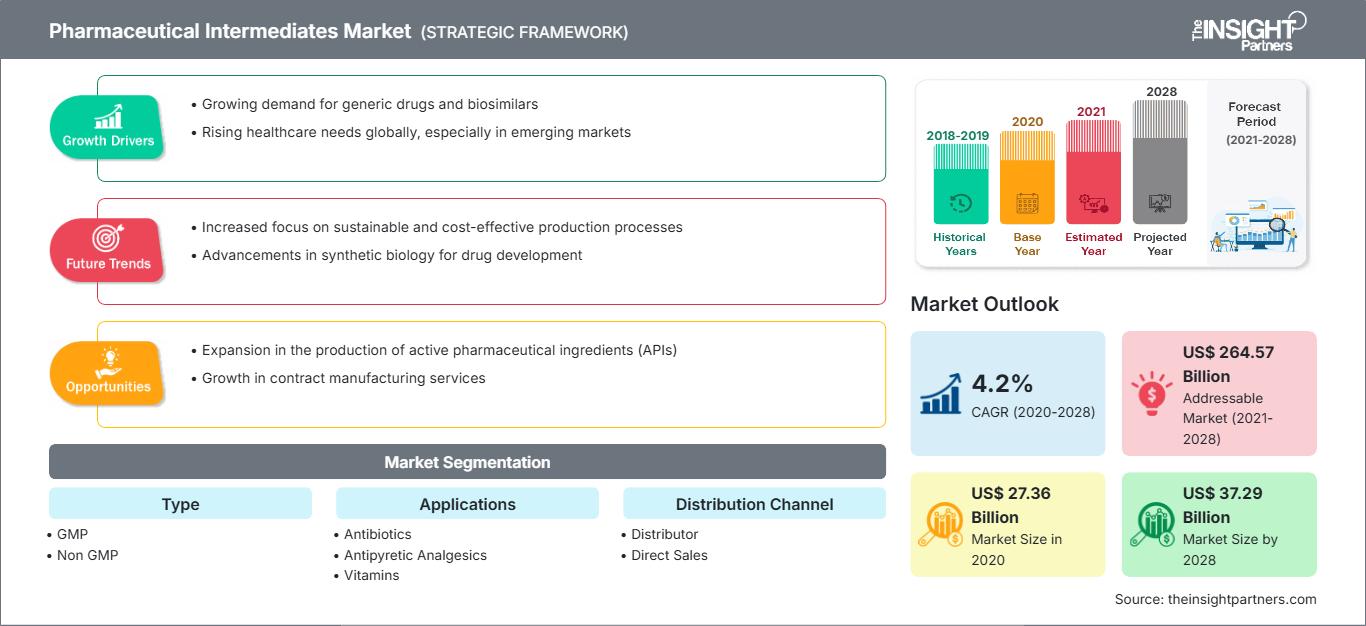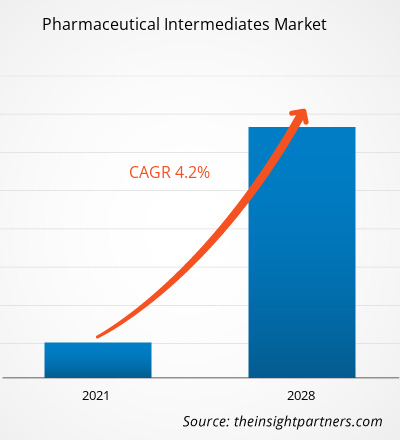Der Markt für pharmazeutische Zwischenprodukte wird voraussichtlich von 27.356,70 Millionen US-Dollar im Jahr 2020 auf 37.290,33 Millionen US-Dollar im Jahr 2028 anwachsen. Von 2021 bis 2028 wird ein durchschnittliches jährliches Wachstum von 4,2 % erwartet.
Der Markt für pharmazeutische Zwischenprodukte wurde nach Typ, Anwendung, Vertriebskanal und Region analysiert. Der Markt ist regional in Nordamerika, Europa, den asiatisch-pazifischen Raum, den Nahen Osten und Afrika sowie Süd- und Mittelamerika unterteilt. Der Bericht konzentriert sich auf Parameter wie Markttrends, technologische Fortschritte, Marktdynamik und die Analyse der Wettbewerbslandschaft führender Unternehmen, um Einblicke und detaillierte Analysen des Marktes für pharmazeutische Zwischenprodukte zu bieten. Er enthält auch eine Analyse der COVID-19-Pandemie in allen wichtigen Regionen.
Passen Sie diesen Bericht Ihren Anforderungen an
Sie erhalten kostenlos Anpassungen an jedem Bericht, einschließlich Teilen dieses Berichts oder einer Analyse auf Länderebene, eines Excel-Datenpakets sowie tolle Angebote und Rabatte für Start-ups und Universitäten.
Markt für pharmazeutische Zwischenprodukte: Strategische Einblicke

-
Holen Sie sich die wichtigsten Markttrends aus diesem Bericht.Dieses KOSTENLOSE Beispiel umfasst Datenanalysen, die von Markttrends bis hin zu Schätzungen und Prognosen reichen.
Pharmazeutische Zwischenprodukte sind die Bausteine pharmazeutischer Wirkstoffe (APIs). Dabei handelt es sich um Rohstoffe, die während der Massenproduktion von Medikamenten molekular verändert oder verarbeitet werden. Daher steigt der Bedarf an pharmazeutischen Zwischenprodukten mit der steigenden Nachfrage nach Medikamenten zur Behandlung chronischer Krankheiten. Laut den Centers for Disease Control and Prevention (CDC) leiden 6 von 10 Erwachsenen in den USA an mindestens einer chronischen Krankheit wie Krebs, Herzkrankheiten, Lungenkrankheiten, Schlaganfall, neurologischen Erkrankungen, Diabetes und Nierenkrankheiten. Darüber hinaus haben 4 von 10 Erwachsenen im Land zwei oder mehr chronische Krankheiten. Und laut der Pressemitteilung der European Chronic Disease Alliance (ECDA) starben im Jahr 2014 in Europa 9 von 10 Menschen an chronischen Krankheiten. Somit werden 70–80 % der gesamten Gesundheitskosten für die Behandlung chronischer Krankheiten aufgewendet.
Die steigende Zahl von Infektionskrankheiten, insbesondere in Südostasien, wird in den kommenden Jahren voraussichtlich auch die Nachfrage nach APIs ankurbeln und so letztendlich das Wachstum des Marktes für pharmazeutische Zwischenprodukte vorantreiben. Laut dem überarbeiteten Bericht des Nationalen Tuberkulose-Kontrollprogramms starben beispielsweise im Jahr 2018 in Indien rund 440.000 Patienten an Tuberkulose, das sind 29 % der insgesamt 1,5 Millionen Todesfälle, die diese Krankheit weltweit verursacht hat. Somit steigert die hohe Prävalenz chronischer Krankheiten und Infektionskrankheiten die Nachfrage nach Medikamenten und unterstreicht letztendlich den Bedarf an pharmazeutischen Zwischenprodukten.
Typbasierte Erkenntnisse
Der Markt für pharmazeutische Zwischenprodukte ist nach Typ in GMP und Nicht-GMP unterteilt. Das GMP-Segment hatte 2020 den größten Marktanteil und dürfte im Prognosezeitraum mit 4,4 % die höchste durchschnittliche jährliche Wachstumsrate (CAGR) verzeichnen.
Anwendungsbasierte Erkenntnisse
Der Markt für pharmazeutische Zwischenprodukte ist nach Anwendung in Antibiotika, fiebersenkende Analgetika, Vitamine und Sonstiges unterteilt. Das Antibiotika-Segment hatte 2020 den größten Marktanteil und dürfte im Prognosezeitraum mit 4,9 % die höchste durchschnittliche jährliche Wachstumsrate (CAGR) verzeichnen.
Vertriebskanalbasierte Erkenntnisse
Auf Grundlage der Vertriebskanäle wurde der Markt für pharmazeutische Zwischenprodukte in Distributoren- und Direktvertrieb segmentiert. Das Direktvertriebssegment hatte im Jahr 2020 den größten Marktanteil, und das Vertriebssegment wird im Prognosezeitraum voraussichtlich die höchste durchschnittliche jährliche Wachstumsrate (CAGR) von 4,2 % verzeichnen.
Unternehmen, die auf dem Markt für pharmazeutische Zwischenprodukte tätig sind, verfolgen organische Strategien wie Produkteinführungen und -erweiterungen, um ihre Präsenz und ihr Produktportfolio weltweit zu erweitern und der wachsenden Nachfrage gerecht zu werden.
Pharmazeutische Zwischenprodukte
Regionale Einblicke in den Markt für pharmazeutische ZwischenprodukteDie Analysten von The Insight Partners haben die regionalen Trends und Faktoren, die den Markt für pharmazeutische Zwischenprodukte im Prognosezeitraum beeinflussen, ausführlich erläutert. In diesem Abschnitt werden auch die Marktsegmente und die geografische Lage pharmazeutischer Zwischenprodukte in Nordamerika, Europa, dem asiatisch-pazifischen Raum, dem Nahen Osten und Afrika sowie Süd- und Mittelamerika erörtert.
Umfang des Marktberichts über pharmazeutische Zwischenprodukte
| Berichtsattribut | Einzelheiten |
|---|---|
| Marktgröße in 2020 | US$ 27.36 Billion |
| Marktgröße nach 2028 | US$ 37.29 Billion |
| Globale CAGR (2020 - 2028) | 4.2% |
| Historische Daten | 2018-2019 |
| Prognosezeitraum | 2021-2028 |
| Abgedeckte Segmente |
By Typ
|
| Abgedeckte Regionen und Länder |
Nordamerika
|
| Marktführer und wichtige Unternehmensprofile |
|
Dichte der Marktteilnehmer für pharmazeutische Zwischenprodukte: Verständnis ihrer Auswirkungen auf die Geschäftsdynamik
Der Markt für pharmazeutische Zwischenprodukte wächst rasant. Die steigende Nachfrage der Endverbraucher ist auf Faktoren wie veränderte Verbraucherpräferenzen, technologische Fortschritte und ein stärkeres Bewusstsein für die Produktvorteile zurückzuführen. Mit der steigenden Nachfrage erweitern Unternehmen ihr Angebot, entwickeln Innovationen, um den Bedürfnissen der Verbraucher gerecht zu werden, und nutzen neue Trends, was das Marktwachstum weiter ankurbelt.

- Holen Sie sich die Markt für pharmazeutische Zwischenprodukte Übersicht der wichtigsten Akteure
- GMP
- Nicht-GMP
Nach Anwendung
- Antibiotika
- Fiebersenkende Analgetika
- Vitamine
- Sonstige
Nach Vertriebskanal
- Distributor
- Direktvertrieb
Nach Geografie
-
Nordamerika
- USA
- Kanada
- Mexiko
-
Europa
- Deutschland
- Frankreich
- Italien
- Vereinigte Königreich
- Spanien
- SchweizEuropa
-
Asien-Pazifik (APAC)
- China
- Indien
- Südkorea
- Japan
- Australien
- Rest von APAC
-
Naher Osten und Afrika (MEA)
- Südafrika
- Saudi Arabien
- VAE
- Türkei
- Rest von MEA
-
Süd- und Mittelamerika (SCAM)
- Brasilien
- Argentinien
- Rest von SCAM
Firmenprofile
- Pfizer, Inc
- Dishman Group
- Dextra Laboratories Limited
- Sanofi Winthrop Industries SA
- Vertellus Holdings LLC
- BASF SE
- Lianhetech
- Codexis
- Midas Pharma GmbH
- Chiracon GmbH
- Historische Analyse (2 Jahre), Basisjahr, Prognose (7 Jahre) mit CAGR
- PEST- und SWOT-Analyse
- Marktgröße Wert/Volumen – Global, Regional, Land
- Branchen- und Wettbewerbslandschaft
- Excel-Datensatz
Aktuelle Berichte
Verwandte Berichte
Erfahrungsberichte
Grund zum Kauf
- Fundierte Entscheidungsfindung
- Marktdynamik verstehen
- Wettbewerbsanalyse
- Kundeneinblicke
- Marktprognosen
- Risikominimierung
- Strategische Planung
- Investitionsbegründung
- Identifizierung neuer Märkte
- Verbesserung von Marketingstrategien
- Steigerung der Betriebseffizienz
- Anpassung an regulatorische Trends






















 Kostenlose Probe anfordern für - Markt für pharmazeutische Zwischenprodukte
Kostenlose Probe anfordern für - Markt für pharmazeutische Zwischenprodukte